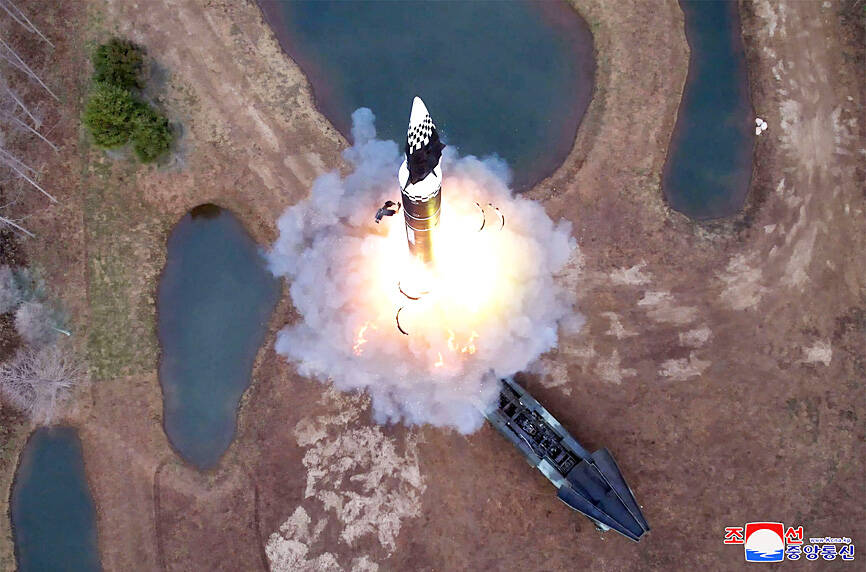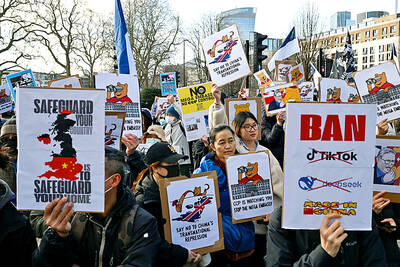Pyongyang successfully test-fired a new hypersonic missile, state-run Korean Central News Agency (KCNA) said yesterday, the latest step in a plan North Korean leader Kim Jong-un described as aimed at using solid fuel to power its entire range of missiles.
The North is developing missiles and nuclear weapons undeterred by sanctions in the wake of UN Security Council bans, while analysts say solid-fuel missiles can be faster to deploy than liquid-fuel variants.
It drew swift condemnation from neighbors South Korea and Japan, as well as the US for firing the intermediate-range ballistic missile (IRBM) into the sea on Tuesday.

Photo: AFP / the Korean Central News Agency via KNS
Kim oversaw the launch of the new Hwasong-16B missile, KCNA said, calling it a strategic weapon showcasing the “absolute superiority” of the North’s defense technology.
It perfects the North’s project for “putting all the tactical, operational and strategic missiles with various ranges on solid-fuelled, warhead-controlled and nuclear warhead-carrying basis,” KCNA quoted Kim as saying.
That would give North Korea the capacity for “rapidly, accurately and powerfully striking any target in the enemy side worldwide,” Kim said.
Analysts said it was unclear if the North would exclusively use solid-fuel missiles, and what the switch would mean for its arsenal of liquid-fuel weapons, such as its largest Hwasong-17 and Hwasong-15 ICBMs.
North Korea might favor solid-fuel systems where possible, but actually phasing out liquid-fuel weapons is likely to play out over years, said Ankit Panda, Stanton senior fellow in the Nuclear Policy Program at the Carnegie Endowment for International Peace.
“There are obvious strategic advantages to an all-solid-fuel force for them in the form of greater promptness, responsiveness and survivability,” he added.
North Korea would need to have high confidence in its production capabilities to allow solid-fuel missiles to sit for a number of years, during which they could develop imperfections that lead to in-flight failures, Panda added.
“India and other countries have had problems with this sort of thing with solid-fuel missiles,” he said. “Liquid-fuel missiles, despite their strategic disadvantages, don’t face this particular long-term handling problem.”
A move away from liquid fuel would be surprising, given recent state media coverage of such weapons, but would make sense if North Korea wants an extremely responsive missile force, said Decker Eveleth, a graduate research assistant at the James Martin Center for Nonproliferation Studies in California.
“Solid-fuel missiles are much, much faster to get off the ground in an emergency,” he said on X.

‘SHORTSIGHTED’: Using aid as leverage is punitive, would not be regarded well among Pacific Island nations and would further open the door for China, an academic said New Zealand has suspended millions of dollars in budget funding to the Cook Islands, it said yesterday, as the relationship between the two constitutionally linked countries continues to deteriorate amid the island group’s deepening ties with China. A spokesperson for New Zealand Minister of Foreign Affairs Winston Peters said in a statement that New Zealand early this month decided to suspend payment of NZ$18.2 million (US$11 million) in core sector support funding for this year and next year as it “relies on a high trust bilateral relationship.” New Zealand and Australia have become increasingly cautious about China’s growing presence in the Pacific

Indonesia’s Mount Lewotobi Laki-Laki yesterday erupted again with giant ash and smoke plumes after forcing evacuations of villages and flight cancelations, including to and from the resort island of Bali. Several eruptions sent ash up to 5km into the sky on Tuesday evening to yesterday afternoon. An eruption on Tuesday afternoon sent thick, gray clouds 10km into the sky that expanded into a mushroom-shaped ash cloud visible as much as 150km kilometers away. The eruption alert was raised on Tuesday to the highest level and the danger zone where people are recommended to leave was expanded to 8km from the crater. Officers also

The team behind the long-awaited Vera Rubin Observatory in Chile yesterday published their first images, revealing breathtaking views of star-forming regions as well as distant galaxies. More than two decades in the making, the giant US-funded telescope sits perched at the summit of Cerro Pachon in central Chile, where dark skies and dry air provide ideal conditions for observing the cosmos. One of the debut images is a composite of 678 exposures taken over just seven hours, capturing the Trifid Nebula and the Lagoon Nebula — both several thousand light-years from Earth — glowing in vivid pinks against orange-red backdrops. The new image

ESPIONAGE: The British government’s decision on the proposed embassy hinges on the security of underground data cables, a former diplomat has said A US intervention over China’s proposed new embassy in London has thrown a potential resolution “up in the air,” campaigners have said, amid concerns over the site’s proximity to a sensitive hub of critical communication cables. The furor over a new “super-embassy” on the edge of London’s financial district was reignited last week when the White House said it was “deeply concerned” over potential Chinese access to “the sensitive communications of one of our closest allies.” The Dutch parliament has also raised concerns about Beijing’s ideal location of Royal Mint Court, on the edge of the City of London, which has so